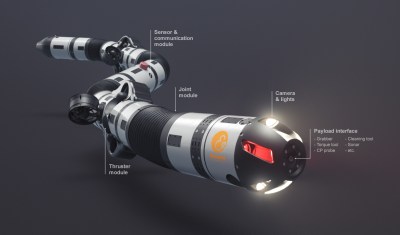We can’t tell if the Eelume actually exists, or if it’s just a good CG and a design concept, but when we saw the video below, we wanted to start working on our version of it immediately. What’s an Eelume? A robotic eel that lives permanently under the ocean.
If you have to take care of something underwater — like a pipeline — this could be much more cost-effective than sending divers to the ocean floor. We liked the natural motion and we really liked the way the unit could switch batteries and tool heads.
 We do have some questions, though. How do you get rid of one battery and pick up another? There would have to be some battery capacity that doesn’t exchange, but that’s not very efficient since the new battery would have to recharge the internal battery. Perhaps you can add batteries at either end. Some of the still pictures don’t clearly show how the batteries fit in, although they do show the flexible joints, sensors, cameras, and thrusters, which are all modular.
We do have some questions, though. How do you get rid of one battery and pick up another? There would have to be some battery capacity that doesn’t exchange, but that’s not very efficient since the new battery would have to recharge the internal battery. Perhaps you can add batteries at either end. Some of the still pictures don’t clearly show how the batteries fit in, although they do show the flexible joints, sensors, cameras, and thrusters, which are all modular.
According to the web site, tools can go on either end and there’s a robot arm. The device can apparently shape itself like a U to bring both ends to bear on the same area. Generally, we like robots that mimic nature, but this is one of the best examples of that being practical we’ve seen.
There’s a video on the site of what appears to be real hardware tethered in a swimming pool, though we couldn’t tell how much of the device was subject to remote control and how much would be autonomous. Communicating underwater is finicky and usually requires either an antenna on the surface or a very low frequency (and, thus, not much bandwidth). While completely duplicating this would probably be a feat, it might inspire some hacker-friendly eels.
A lot of underwater vehicles seem to emulate biologic life. Shape-wise we had to remember [Alex Williams’] award-winning underwater glider, even though it doesn’t undulate.
















The cg video shows a buoy tethered to their little hut for power and outside communication. Probably directed to go on short autonomous missions.
CG and a design concept…
Looks like a cool idea though
Almost as real as the Sentinels in the Matrix movies then, make those, they looked cooler.
At least two batteries. Switch to B, replace A. Later, switch to A and replace B. I´m more curious about the propulsion and sensors/actuators to be able to do something useful, like fixing a leak or reconnecting a disconnected/broken cable.
The most impotant question is: are they using an hovercraft to move the robotic ells? Ant the tobacconist is scratched?
I don’t know where they will find such gas pipelines so neatly laid over the ground, without debris falling over them, or algae growing everywhere. Real world environment will surely be way more challenging than this CGI. And I don’t believe that the “wave energy” buoy will generate enough energy to power the robots, all sensors, and data uplink. It’s way too small for that.
Nice concept, though. Quickly replaceable batteries are a nice touch.
Since they are still machines with moving parts, being underwater “permanently” is more likely to be a couple years. There’s also the issue of the lasers burning out. It’s a nice concept but I don’t see it overtaking our current systems of sending inspection robots down ad hoc.
OC Robotics makes robots similar to these. The prototype design that I saw in use was capable of working in a 7 bar environment underground. It was eventually used on a project in China, if I’m not mistaken. Their website has a few videos showcasing a couple of different models they currently produce.
Cool marketing video….
worthless scifi, there is no real life difficulty in CG
imagine a puny robot pulling 1ton pipes
alga growing in the propeller
…
You couldn’t tell if that was CGI or not..?